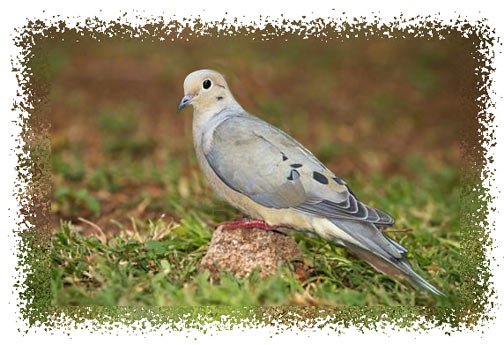

The Mourning Dove, Zenaidura macroura, is the only common species over most of the northern United States and Canada now that the passenger pigeon is gone. Also known as the Turtle Dove, the mourning dove does not nest in dense colonies as did the passenger pigeons, and so has survived in goodly numbers. Mourning doves, when mated, are among the most affectionate honeymooners in the bird kingdom. Apparently they give little attention to such practical matters as nest-building, for the structure is usually a flimsy affair, set up without an eye to the best shelter and protection. The two white eggs are consequently at the mercy of crows, snakes, cats and other enemies. Perhaps as nature's way of making up for these hazards, the doves produce two or more broods during the mating season.
 Mourning doves feed mostly on seeds, which does not endear them to the prosaic farmer. They have a familiar call of "coo-wee-oo, coo-o-o, coo-o-o, coo-o-o," which may strike you as gentle or mournful, depending on your mood. These birds spend the winter in Mexico and the southern states.
Mourning doves feed mostly on seeds, which does not endear them to the prosaic farmer. They have a familiar call of "coo-wee-oo, coo-o-o, coo-o-o, coo-o-o," which may strike you as gentle or mournful, depending on your mood. These birds spend the winter in Mexico and the southern states.
The appearance of the mourning dove is quite similar to its vanished cousin's, but the passenger pigeon was somewhat larger and had a strong reddish tint on its breast. A slender bird, the mourning dove is brownish, tinted with lavender. The tail is pointed and you can see the large white spots near its tip when the bird takes off or alights. Whenever the mourning dove springs into the air its wings beat together noisily - a characteristic of many doves.
There are several dove gifts at our sponsor's online giftshop. See them at our sponsor's online website: Jeannie's Cottage LLC.



